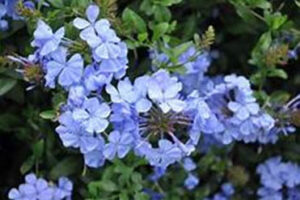By Jessie Clark
Master Gardener
While some plants may express their resentment of the desert heat in the summer, well-established plumbago shrubs bloom in Midland and Odessa well until frost. This plant loves our West Texas sunshine and well-draining soil. While the blue variety, Plumbago auriculata (commonly referred to as “Cape Plumbago”) is often most recognizable for its rare blue flower color, it is the white variety, Plumbago zeylanica (“Doctorbrush” or “Mexican Plumbago”), that finds a spot on our recommended plant list in West Texas. Plumbago zeylanica is cold-tolerant down to ten degrees. It is drought-tolerant once established though performs best with regular watering and sunshine. This plant reaches 3-4’ tall. Plumbago zeylanica plant is a butterfly magnet, blooming constantly from Spring to Fall. In zones 9-11 Plumbago can be a perennial, however in our region it is typically grown as an annual.

Check out the Dwarf Plumbago, Ceratostigma plumbaginoides. Leadwort commonly refers to both Dwarf Plumbago and Cape Plumbago, however they are from a different taxonomic genera. In addition to growth pattern and bloom season, you will also be able to tell a difference between these two by looking at their flower petals. Dwarf Plumbago flowers curl at the tip while Cape Plumbago flowers do not. Dwarf plumbago reaches 6-8” in height, is drought-tolerant and can sustain temperatures down to negative twenty Fahrenheit. Additionally, this variety begins blooming in the fall, adding color after many other plants are done blooming for the season.
All varieties of plumbago are considered ground cover which can help prevent soil erosion, fend off weeds, and add border appeal with a pop of color. Plumbago blooms attract pollinators and beneficial insects that can help you fight off harmful insects.
If you have limited space to plant in the ground, consider planting plumbago in a container. If using a container, use fresh soil mixed in with compost at time of planting. Once planted, add a layer of mulch on the surface of the soil leaving a few inches of space between the mulch and plant stem. Container plants aren’t able to reach water reserves in the ground with their roots so they benefit greatly from irrigation such as a hose connected to a faucet timer. While plumbago is drought-tolerant, it will bloom best for you with regular watering. Remember to allow the top few inches of soil to become dry between waterings.
Consider planting Plumbago zeylanica or Ceratostigma plumbaginoides in your 2022 Spring landscape!



